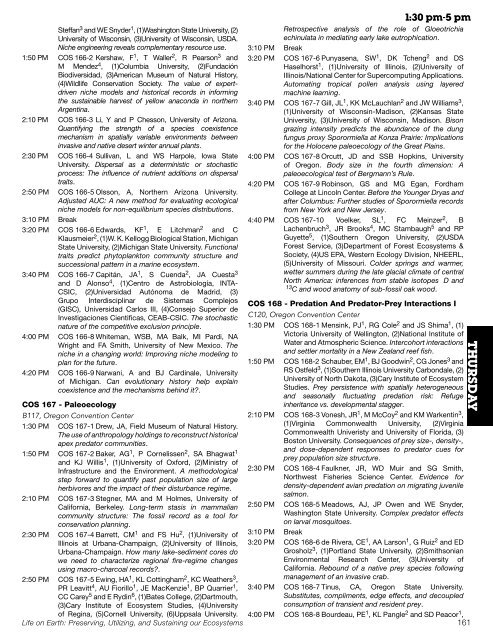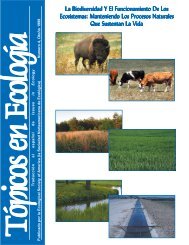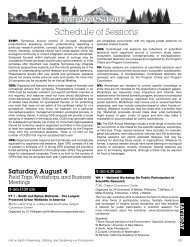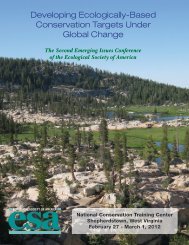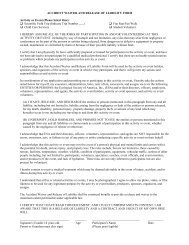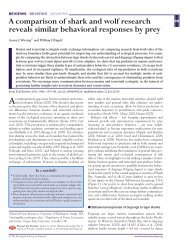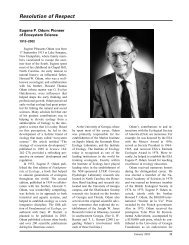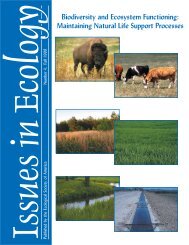Printed Program (PDF) - Ecological Society of America
Printed Program (PDF) - Ecological Society of America
Printed Program (PDF) - Ecological Society of America
Create successful ePaper yourself
Turn your PDF publications into a flip-book with our unique Google optimized e-Paper software.
1:30 pm-5 pm<br />
Steffan<br />
Life on Earth: Preserving, Utilizing, and Sustaining our Ecosystems<br />
161<br />
3 and WE Snyder1 , (1)Washington State University, (2)<br />
University <strong>of</strong> Wisconsin, (3)University <strong>of</strong> Wisconsin, USDA.<br />
Niche engineering reveals complementary resource use.<br />
1:50 PM COS 166-2 Kershaw, F1 , T Waller2 , R Pearson3 and<br />
M Mendez4 , (1)Columbia University, (2)Fundación<br />
Biodiversidad, (3)<strong>America</strong>n Museum <strong>of</strong> Natural History,<br />
(4)Wildlife Conservation <strong>Society</strong>. The value <strong>of</strong> expertdriven<br />
niche models and historical records in informing<br />
the sustainable harvest <strong>of</strong> yellow anaconda in northern<br />
Argentina.<br />
2:10 PM COS 166-3 Li, Y and P Chesson, University <strong>of</strong> Arizona.<br />
Quantifying the strength <strong>of</strong> a species coexistence<br />
mechanism in spatially variable environments between<br />
invasive and native desert winter annual plants.<br />
2:30 PM COS 166-4 Sullivan, L and WS Harpole, Iowa State<br />
University. Dispersal as a deterministic or stochastic<br />
process: The influence <strong>of</strong> nutrient additions on dispersal<br />
traits.<br />
2:50 PM COS 166-5 Olsson, A, Northern Arizona University.<br />
Adjusted AUC: A new method for evaluating ecological<br />
niche models for non-equilibrium species distributions.<br />
3:10 PM Break<br />
3:20 PM COS 166-6 Edwards, KF1 , E Litchman2 and C<br />
Klausmeier2 , (1)W. K. Kellogg Biological Station, Michigan<br />
State University, (2)Michigan State University. Functional<br />
traits predict phytoplankton community structure and<br />
successional pattern in a marine ecosystem.<br />
3:40 PM COS 166-7 Capitán, JA1 , S Cuenda2 , JA Cuesta3 and D Alonso4 , (1)Centro de Astrobiología, INTA-<br />
CSIC, (2)Universidad Autónoma de Madrid, (3)<br />
Grupo Interdisciplinar de Sistemas Complejos<br />
(GISC), Universidad Carlos III, (4)Consejo Superior de<br />
Investigaciones Cientificas, CEAB-CSIC. The stochastic<br />
nature <strong>of</strong> the competitive exclusion principle.<br />
4:00 PM COS 166-8 Whiteman, WSB, MA Balk, MI Pardi, NA<br />
Wright and FA Smith, University <strong>of</strong> New Mexico. The<br />
niche in a changing world: Improving niche modeling to<br />
plan for the future.<br />
4:20 PM COS 166-9 Narwani, A and BJ Cardinale, University<br />
<strong>of</strong> Michigan. Can evolutionary history help explain<br />
coexistence and the mechanisms behind it?.<br />
COS 167 - Paleoecology<br />
B117, Oregon Convention Center<br />
1:30 PM COS 167-1 Drew, JA, Field Museum <strong>of</strong> Natural History.<br />
The use <strong>of</strong> anthropology holdings to reconstruct historical<br />
apex predator communities.<br />
1:50 PM COS 167-2 Baker, AG1 , P Cornelissen2 , SA Bhagwat1 and KJ Willis1 , (1)University <strong>of</strong> Oxford, (2)Ministry <strong>of</strong><br />
Infrastructure and the Environment. A methodological<br />
step forward to quantify past population size <strong>of</strong> large<br />
herbivores and the impact <strong>of</strong> their disturbance regime.<br />
2:10 PM COS 167-3 Stegner, MA and M Holmes, University <strong>of</strong><br />
California, Berkeley. Long-term stasis in mammalian<br />
community structure: The fossil record as a tool for<br />
conservation planning.<br />
2:30 PM COS 167-4 Barrett, CM1 and FS Hu2 , (1)University <strong>of</strong><br />
Illinois at Urbana-Champaign, (2)University <strong>of</strong> Illinois,<br />
Urbana-Champaign. How many lake-sediment cores do<br />
we need to characterize regional fire-regime changes<br />
using macro-charcoal records?.<br />
2:50 PM COS 167-5 Ewing, HA1 , KL Cottingham2 , KC Weathers3 ,<br />
PR Leavitt4 , AU Fiorillo1 , JE MacKenzie1 , BP Quarrier1 ,<br />
CC Carey5 and E Rydin6 Retrospective analysis <strong>of</strong> the role <strong>of</strong> Gloeotrichia<br />
echinulata in mediating early lake eutrophication.<br />
3:10 PM Break<br />
3:20 PM COS 167-6 Punyasena, SW<br />
, (1)Bates College, (2)Dartmouth,<br />
(3)Cary Institute <strong>of</strong> Ecosystem Studies, (4)University<br />
<strong>of</strong> Regina, (5)Cornell University, (6)Uppsala University.<br />
1 , DK Tcheng2 and DS<br />
Haselhorst1 , (1)University <strong>of</strong> Illinois, (2)University <strong>of</strong><br />
Illinois/National Center for Supercomputing Applications.<br />
Automating tropical pollen analysis using layered<br />
machine learning.<br />
3:40 PM COS 167-7 Gill, JL1 , KK McLauchlan2 and JW Williams3 ,<br />
(1)University <strong>of</strong> Wisconsin-Madison, (2)Kansas State<br />
University, (3)University <strong>of</strong> Wisconsin, Madison. Bison<br />
grazing intensity predicts the abundance <strong>of</strong> the dung<br />
fungus proxy Sporormiella at Konza Prairie: Implications<br />
for the Holocene paleoecology <strong>of</strong> the Great Plains.<br />
4:00 PM COS 167-8 Orcutt, JD and SSB Hopkins, University<br />
<strong>of</strong> Oregon. Body size in the fourth dimension: A<br />
paleoecological test <strong>of</strong> Bergmann’s Rule.<br />
4:20 PM COS 167-9 Robinson, GS and MG Egan, Fordham<br />
College at Lincoln Center. Before the Younger Dryas and<br />
after Columbus: Further studies <strong>of</strong> Sporormiella records<br />
from New York and New Jersey.<br />
4:40 PM COS 167-10 Voelker, SL1 , FC Meinzer2 , B<br />
Lachenbruch3 , JR Brooks4 , MC Stambaugh5 and RP<br />
Guyette5 , (1)Southern Oregon University, (2)USDA<br />
Forest Service, (3)Department <strong>of</strong> Forest Ecosystems &<br />
<strong>Society</strong>, (4)US EPA, Western Ecology Division, NHEERL,<br />
(5)University <strong>of</strong> Missouri. Colder springs and warmer,<br />
wetter summers during the late glacial climate <strong>of</strong> central<br />
North <strong>America</strong>: inferences from stable isotopes δD and<br />
δ13C and wood anatomy <strong>of</strong> sub-fossil oak wood.<br />
COS 168 - Predation And Predator-Prey Interactions I<br />
C120, Oregon Convention Center<br />
1:30 PM COS 168-1 Mensink, PJ1 , RG Cole2 and JS Shima1 , (1)<br />
1:50 PM<br />
Victoria University <strong>of</strong> Wellington, (2)National Institute <strong>of</strong><br />
Water and Atmospheric Science. Intercohort interactions<br />
and settler mortality in a New Zealand reef fish.<br />
COS 168-2 Schauber, EM1 , BJ Goodwin2 , CG Jones3 and<br />
RS Ostfeld3 , (1)Southern Illinois University Carbondale, (2)<br />
University <strong>of</strong> North Dakota, (3)Cary Institute <strong>of</strong> Ecosystem<br />
Studies. Prey persistence with spatially heterogeneous<br />
and seasonally fluctuating predation risk: Refuge<br />
inheritance vs. developmental stagger.<br />
2:10 PM COS 168-3 Vonesh, JR1 , M McCoy2 and KM Warkentin3 ,<br />
(1)Virginia Commonwealth University, (2)Virginia<br />
Commonwealth Univeristy and University <strong>of</strong> Florida, (3)<br />
Boston University. Consequences <strong>of</strong> prey size-, density-,<br />
and dose-dependent responses to predator cues for<br />
prey population size structure.<br />
2:30 PM COS 168-4 Faulkner, JR, WD Muir and SG Smith,<br />
Northwest Fisheries Science Center. Evidence for<br />
density-dependent avian predation on migrating juvenile<br />
salmon.<br />
2:50 PM COS 168-5 Meadows, AJ, JP Owen and WE Snyder,<br />
Washington State University. Complex predator effects<br />
on larval mosquitoes.<br />
3:10 PM<br />
3:20 PM<br />
Break<br />
COS 168-6 de Rivera, CE1 , AA Larson1 , G Ruiz2 and ED<br />
Grosholz3 , (1)Portland State University, (2)Smithsonian<br />
Environmental Research Center, (3)University <strong>of</strong><br />
California. Rebound <strong>of</strong> a native prey species following<br />
management <strong>of</strong> an invasive crab.<br />
3:40 PM COS 168-7 Tinus, CA, Oregon State University.<br />
Substitutes, compliments, edge effects, and decoupled<br />
consumption <strong>of</strong> transient and resident prey.<br />
4:00 PM COS 168-8 Bourdeau, PE1 , KL Pangle2 and SD Peacor1 ,<br />
THURSDAY


